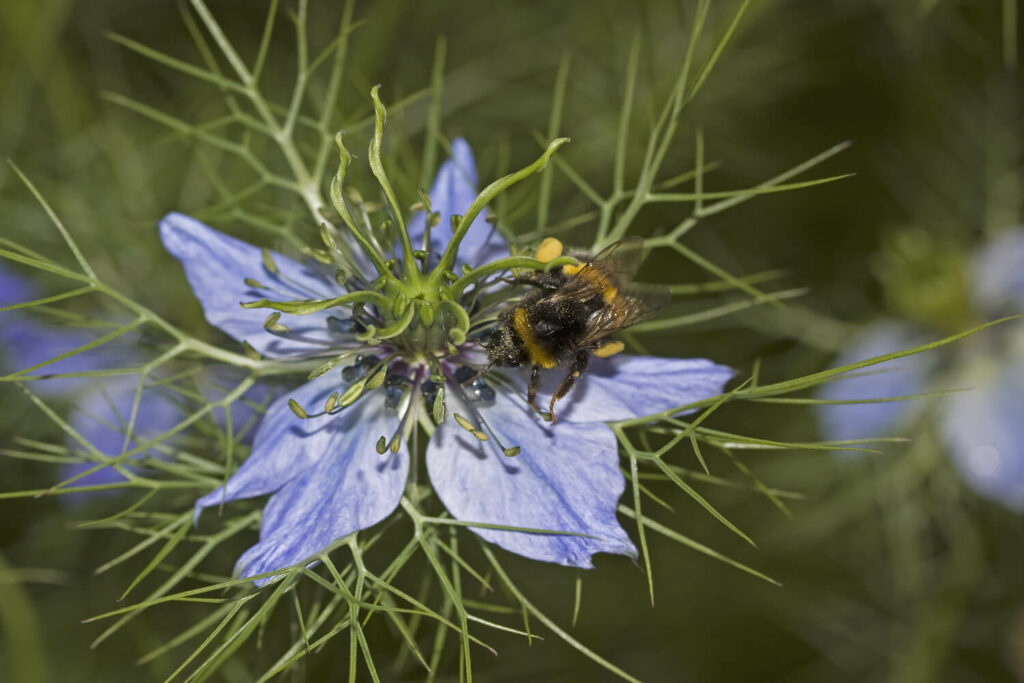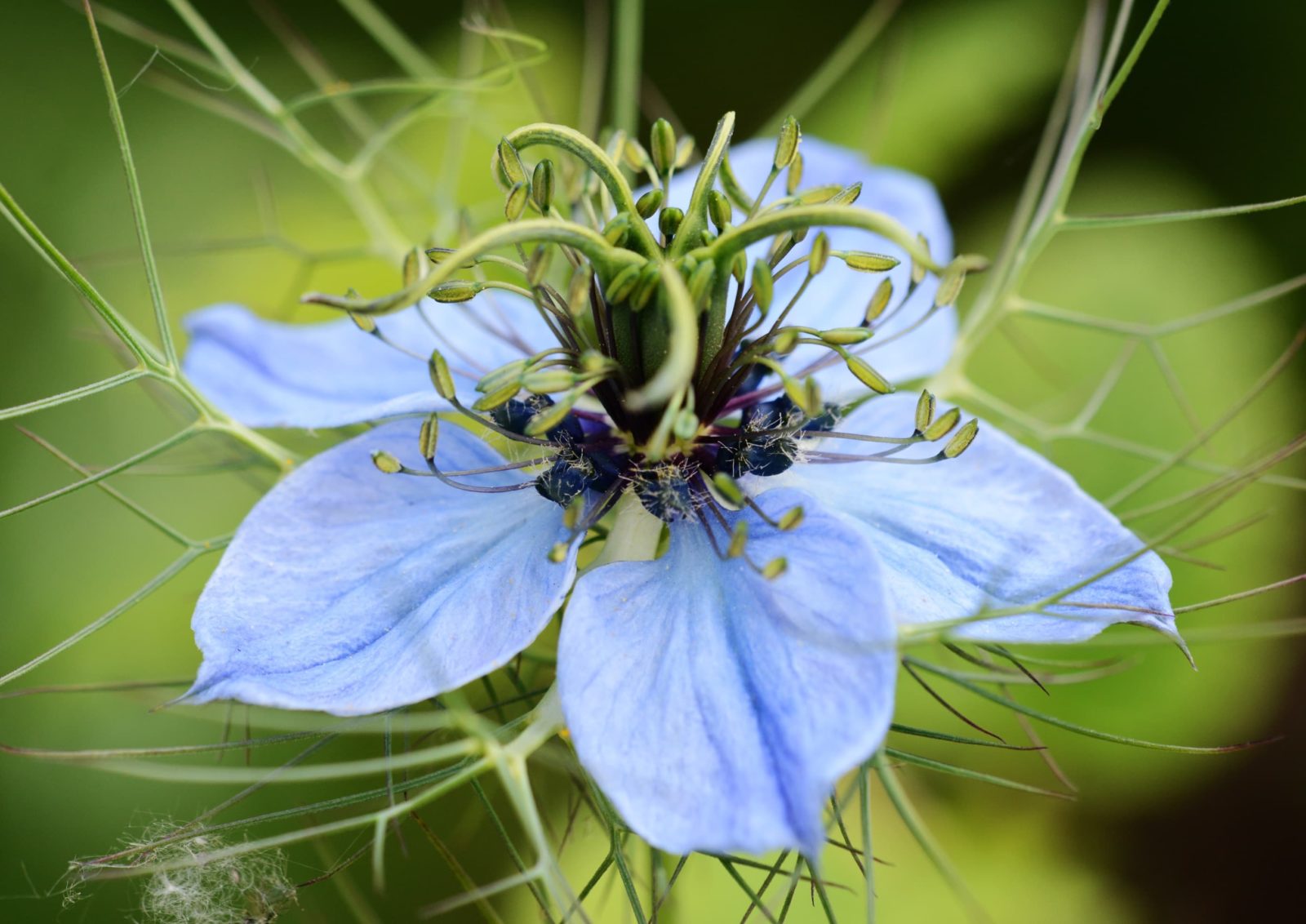The delicate and intricate love in the mist flower has captivated gardeners and florists for centuries with its unique appearance and rich symbolic meaning. This annual in the Ranunculaceae family goes by many names, including devil in a bush, ragged lady, and blue spiderflower, each nodding to its distinctive frilly, weblike bracts encircling the blossoms. But its most oft-used common name gives a glimpse into the flower’s historic significance and the air of mystery and romance associated with it.
A Brief History of the Love in the Mist Flower
Love in the mist has its origins in the Mediterranean region and parts of Europe and Asia. The wispy annual has been grown ornamentally for ages and used for its seeds and essential oil. But this charming flower gained its claim to fame through the Victorian-era language of flowers, in which every bloom carried a coded message. Gifting bouquets and “tussy-mussies,” small flower arrangements, provided a way for Victorians to express emotions that otherwise remained unspoken. And the love in the mist flower came to epitomize the intrigue, perplexity, and openness to love inherent in new romances and courtships.
The Meaning and Symbolism Tied to the Love in the Mist Flower
During the Victorian period, flowers became a tool for covertly communicating deeper meanings and sentiments. And love in the mist flowers came to signify several interrelated concepts according to this floral lexicon:
- Perplexity or confusion – The idea that love can be confusing and leave one full of questions when feelings are ambiguous fits well with the flower’s delicate and complex appearance The giver implies that the relationship feels vexing but open.
- “You puzzle me” – Directly related to perplexity telling someone “you puzzle me” via love in the mist flowers suggests intrigued befuddlement. The recipient is enigmatic in an appealing way.
- Openness to love – If the flowers are sent with romance in mind, they indicate an openness to falling in love and reciprocal feelings. The giver is essentially saying, “I don’t fully understand these emotions between us, but I’m willing to explore and see where they lead.”
- “Kiss me” – Perhaps the most direct of the coded meanings, gifting these flowers can be a request for a kiss from the recipient. The flowers hint that the giver feels a kiss is desired or imminent as the relationship progresses.
Examples of Common Ways Love in the Mist Flowers Are Given
Victorians carefully selected flowers and crafted their tussy-mussies to share thoughtful sentiments. Here are a few scenarios one might have used love in the mist to express themselves:
- A woman hoped to get a kiss from a gentleman of interest, so she gifted him a small bouquet with love in the mist flowers prominently featured to convey her wish.
- A man courting a lady found her difficult to read at times; he sent white love in the mist flowers to signify she puzzles him but he remains open to love’s possibilities.
- Friends noticed a woman had fallen for a childhood companion. They delivered a tussy-mussy with love in the mist blooms to show they understand she’s in a state of perplexed but openhearted love as she sorts out her feelings.
- An ill wife received blue love in the mist arrangements from her husband regularly to symbolically say, “You puzzle me and I love you openly – kiss me and get well soon, my darling.”
So Victorians could creatively use this delicate flower in many ways to communicate the head-spinning, vulnerable beginnings of romance.
The Enduring Intrigue of Love in the Mist
Today, love in the mist remains a favorite cottage garden flower prized for its airy appearance and sweet yet spicy fragrance. And even if not purposefully used to send coded messages, the blossoms retain an aura of mystery and old-fashioned romance. The idea that flowers can symbolize our deepest feelings still resonates. And for many, enjoying the sight and scent of wispy love in the mist blooms in their garden connects them to generations past when flowers spoke volumes and new Admiration stirred the heart and mind.
Though no longer used formally as a “language of flowers,” this delicate annual remains a keepsake of history. Its historic meanings give love in the mist a certain poetic charm that fascinates lovers of flowers and romantic symbolism alike.
Caring for love-in-a-mist
Despite its hardy and adaptable nature, love-in-a-mist plants, especially potted ones, do need a bit of TLC.

Nigella damascena only needs to be watered in prolonged periods of heat. The plant copes quite well with drought and does not require daily watering. If your love-in-a-mist plant is in a pot, use a finger test to see how much water it needs every few days. If the top few centimetres of the soil are dry, it is time to water again.
Tip: A layer of mulch, like pine bark, keeps weeds from growing and stops water from evaporating from the soil, which could kill Nigella damascena plants.
Fertilising is also usually only necessary for potted love-in-a-mist plants. Give the plant a small amount of fertilizer every 14 days while it’s flowering, like our Plantura Liquid Flower Food, to make sure it gets all the nutrients it needs.
Nigella damascena is an annual, which means it will die out at the end of the season. That being said, love-in-a-mist are prolific self-seeders that produce lots of seeds to regrow the following year. Cut back the plants of love-in-mist before the seeds ripen in late summer to stop them from spreading out of control.

After flowering, love-in-a-mist plants will develop seed pods. Nigella damascena seeds look extremely decorative and are often used for dried bouquets. Take the plant’s stems and cut them off at the base. Then, hang them upside down with string to dry.
To harvest edible love-in-a-mist seeds, wait until the capsules on the plants start to turn brown. Afterward, harvest and dry them in a shallow dish on kitchen paper until they are papery. At this stage, the capsules should be starting to crack at the top. Spread the seeds out on clean paper and shake them to get rid of any unwanted things like seed pests. Next, put the seeds somewhere cool, dark, and dry.

Love-in-a-mist: origin and characteristics
Love-in-a-mist is a herbaceous annual that grows naturally in the Mediterranean. It belongs to the genus Nigella which is a part of the Ranuncalaceae or crowfoot family. Love-in-a-mist is only one of many names for this plant including:
- Bird’s nest
- Blue spiderflower
- Devil in the bush
- Blue crown
- Ragged lady
What are all of these names for Nigella damascena? Most of them come from the way it looks, with its blue flowers surrounded by finely split bracts that look like hairs or a spider’s web.
Tip: Like chicory, yarrow and cornflower, love-in-a-mist is a symbol of unrequited love. If you should be unlucky enough to receive a love-in-a-mist bouquet, it should be interpreted as a rejection.
The question still stands: When do the famous love-in-a-mist flowers bloom? Nigella damascena flowers naturally from June to September, which is when the love-in-a-mist flowers are most likely to attract bees and other helpful pollinators. Fortunately, however, the plants are usually overlooked by the common garden pest, the snail. Love-in-a-mist will also fruit while it’s flowering. The tiny fruit capsules inside will release seeds that will grow again next year. Nigella damascena usually grows up to 45cm tall, but sometimes reaches around 70cm in height.

Love-in-a-mist and black cumin are both plants in the same genus, Nigella. What’s the difference between them? However, it is easy to tell them apart by their leaves. True black cumin (Nigella sativa) has no hair-like bracts and looks altogether less delicate. True black cumin is used in the kitchen more often and in different ways than love-in-mist seeds because it tastes hotter.
SEED STORIES | Love In A Mist: An Ethereal Beauty
FAQ
What does the mist flower symbolize?
What is the meaning of love-in-a-mist plant?
What is love-in-a-mist used for?
What is the love-in-a-mist flower essence?
What is a love in a mist flower?
Instead of unattractive bare spaces after bulbs finish blooming, you will see “love” in their place. Love-in-a-mist is a standout cut flower. Also, the horned, pod-shaped seed heads are marvelous in fresh or dried arrangements. Above: Nigella damascena. Photograph by Maggie McCain via Flickr. Love-in-a-mist is a prolific re-seeder.
What does a mist flower mean?
The Love in a Mist flower is often associated with intricate emotions and the complexities of love, thanks to its tangled, “misty” appearance. It symbolizes the confusing and at times, difficult-to-navigate aspects of love and relationships.
What does love in a mist look like?
The plant’s common name “love-in-a-mist” comes from the flower being nestled in a ring of multifid, lacy bracts . It grows to 20–50 cm (8–20 in) tall, with pinnately divided, thread-like, alternate leaves. The flowers, blooming in early summer, are most commonly different shades of blue, but can be white, pink, or pale purple, with 5 to 25 sepals.
When do Love in a mist flowers bloom?
Best known for the vivid blue-blossom variety, love-in-a-mist also has cultivars that bloom in purples, pinks, and white. Plant these adaptable flowers in the spring or even in the fall. The plants grow to nearly two feet tall and bloom for several weeks, starting in the late spring. When they reseed on their own, you’ll have blooms through fall.
- The Ultimate Guide to Growing Strawberries in Raised Beds - August 8, 2025
- No-Dig Garden Beds: The Easiest Way to Grow a Beautiful Garden - August 6, 2025
- How to Protect and Preserve Wood for Raised Garden Beds - August 6, 2025

